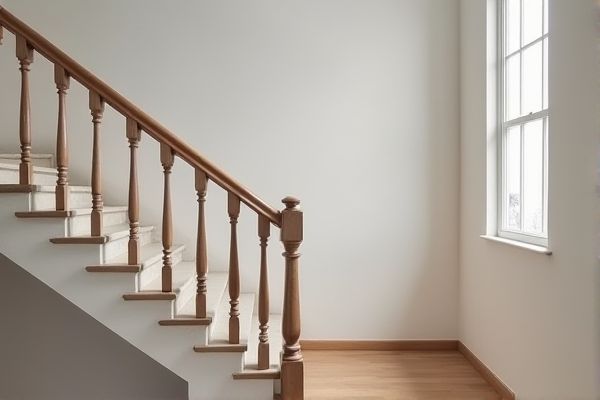
Minimalist handrails offer a sleek, modern aesthetic with clean lines and often use materials like stainless steel or glass, providing unobstructed views and a sense of openness. Discover how your choice between minimalist and traditional handrails can impact both the style and functionality of your space by reading the full article.
Table of Comparison
| Feature | Minimalist Handrail | Traditional Handrail |
|---|---|---|
| Design | Sleek, simple, modern | Ornate, detailed, classic |
| Materials | Metal, glass, wood with clean lines | Wood, wrought iron, brass with decorative elements |
| Installation | Quick, easy, less hardware | Complex, requires skilled labor |
| Maintenance | Low maintenance, easy to clean | Requires regular polishing and upkeep |
| Cost | Moderate to high | Varies widely, often moderate |
| Aesthetic Appeal | Modern, minimalist, visually lightweight | Traditional, classic, visually heavy |
| Space Efficiency | Optimizes space, less bulky | Can be bulky or intrusive |
Overview of Minimalist and Traditional Handrails
Minimalist handrails emphasize sleek, clean lines with materials like stainless steel or glass, offering a modern and unobtrusive aesthetic that enhances open spaces. Traditional handrails often feature ornate designs crafted from wood or wrought iron, providing a classic and decorative touch to staircases. Your choice between minimalist and traditional handrails can significantly impact the visual style and ambiance of your interior design.
Key Design Principles
Minimalist handrails emphasize clean lines, simplicity, and unobtrusive materials like glass or thin metal profiles to create a sleek, modern aesthetic. Traditional handrails prioritize robust craftsmanship, often featuring ornate details and heavier wooden or metal components that showcase classic design elements. Your choice should align with the architectural style and visual impact you want to achieve, balancing functionality with the overall design principle.
Material Choices and Longevity
Minimalist handrails often utilize materials like stainless steel, glass, and aluminum, which offer sleek aesthetics and superior resistance to corrosion, contributing to extended longevity. Traditional handrails typically employ wood or wrought iron, which may require regular maintenance to prevent wear and deterioration. The durability of minimalist materials generally surpasses traditional options, reducing the need for frequent repairs or replacements.
Aesthetic Impact on Interiors
Minimalist handrails offer sleek, unobtrusive lines that enhance modern interiors by creating a sense of openness and allowing architectural features to stand out. Traditional handrails, often crafted from ornate wood or wrought iron, add character and warmth, complementing classic or rustic decor styles. Choosing your handrail style can dramatically influence the aesthetic impact, either by maintaining visual simplicity with minimalism or by introducing intricate details through traditional designs.
Installation Complexity
Minimalist handrails typically feature sleek, simple designs with fewer components, making installation faster and less complicated compared to traditional handrails. Traditional handrails often require more intricate joinery, additional brackets, and detailed craftsmanship, increasing installation time and complexity. Choosing a minimalist handrail can simplify your project by reducing the need for specialized tools and labor.
Safety and Compliance Considerations
Minimalist handrails prioritize sleek design without compromising safety, often meeting modern building codes with materials like stainless steel or tempered glass. Traditional handrails provide robust support with established standards, commonly made from wood or metal, ensuring reliability in various environments. Your choice should consider compliance with local regulations and the specific safety requirements of your space to protect users effectively.
Maintenance Requirements
Minimalist handrails typically offer lower maintenance requirements due to their sleek design and use of durable materials such as stainless steel or tempered glass, which resist corrosion and staining. Traditional handrails, often made from wood or wrought iron, demand regular upkeep including sanding, painting, or sealing to prevent wear and damage from moisture and environmental exposure. Choosing minimalist handrails can lead to long-term cost savings and reduced labor due to their simpler cleaning processes and enhanced resistance to aging factors.
Cost Comparison
Minimalist handrails typically cost less due to their streamlined design and reduced material use compared to traditional handrails, which often require more intricate craftsmanship and heavier materials like wood or wrought iron. Installation expenses for minimalist handrails tend to be lower because of simpler mounting processes and fewer components. Maintenance costs are also generally reduced for minimalist designs as they have fewer crevices that accumulate dirt or require frequent refinishing.
Suitability for Different Architectural Styles
Minimalist handrails are highly suitable for modern and contemporary architectural styles, emphasizing clean lines, simplicity, and open spaces that enhance visual flow. Traditional handrails complement classic and historical architecture, featuring intricate details, ornamental carvings, and materials such as wood or wrought iron that add warmth and character. Choosing between minimalist and traditional handrails depends on the desired aesthetic coherence and integration with the overall architectural design.
Sustainability and Environmental Impact
Minimalist handrails often use fewer materials and incorporate sustainable resources like recycled metals or bamboo, significantly reducing environmental impact compared to traditional handrails made from heavier, less eco-friendly materials. Their streamlined design lowers energy consumption during manufacturing and simplifies maintenance, contributing to a smaller carbon footprint over time. Choosing minimalist handrails can enhance Your project's sustainability by prioritizing resource efficiency and promoting eco-conscious construction practices.
 homyna.com
homyna.com